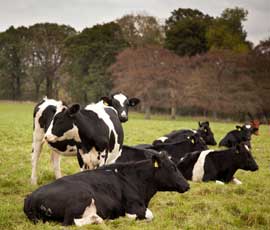Adopt structured feeding programme for better returns

Instead of trying to trim back on heifer feed costs, producers should instead adopt a structured feeding programme to deliver good growth rates, healthy heifers and improved milk production in the first lactation, according to Spanish research.
Alex Bach of the Department of Ruminant Production, IRTA, told delegates to the Large Herd Seminar that feed targets for rearing heifers had to be set. “For each stage of growth the heifer needs a different diet. If a heifer under performs in early life it can have a life-long effect on her production.”
There was a simple rule to be followed, he said. “As a heifer grows, decreasing energy and protein in the diet in line with her needs gives you maximum economic advantage.”
Heifer calves should be reared on a quality replacer or whole milk. If using replacer, it should provide 20% fat, 27% protein and be diluted at 12.5-15% using 45-55C water to make sure components are diluted thoroughly.
“Make sure calves have access to fresh, clean water. At two weeks a heifer calf can drink a litre of water on top of the milk replacer. This increases with age,” explained Dr Bach.
Offering a quality 18% protein (minimum 2.9 Mcal ME/kg) weaning pellet early would stimulate rumen development and appetite. “Make sure it is made of palatable ingredients – wheat, barley, sorghum and maize (but not oats) for energy, and SBM or sunflower (but not pulses or rapemeal) for protein.”
Chopped forage (2.5cm long), offered alongside pelleted feed before weaning, increased intake by up to 20%. Oat straw was better than alfalfa. This increased the likelihood of heifer calves achieving daily liveweight gain of at least 1kg at weaning – critical as strong early growth had a direct effect on improved milk yield in first lactation by up to 1,000 litres/heifer.
“At transition (from pelleted feed to forage) the risk of respiratory disease and poor growth increases. You must provide a good environment for the calf and guarantee adequate nutrition for health and growth,” he warned.
A dry TMR diet was preferable to forage and straw fed separately to avoid heifers “sorting” what they eat. Aim to provide 18-20% protein and 2.73 Mcal ME/kg post weaning and 17% protein and 2.1 Mcal ME/kg through to breeding, he said. “It is preferable to avoid changes to the diet in the two months before calving.”
